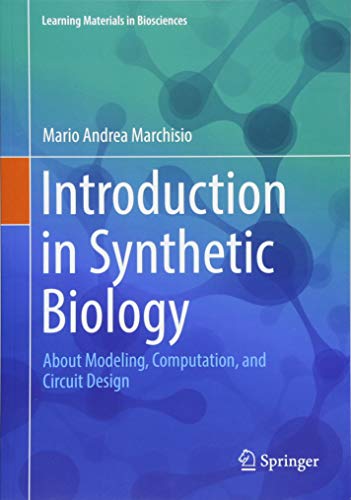Finding the best synthetic biology suitable for your needs isnt easy. With hundreds of choices can distract you. Knowing whats bad and whats good can be something of a minefield. In this article, weve done the hard work for you.
Best synthetic biology
1. Synthetic Biology: Parts, Devices and Applications (Advanced Biotechnology)
Description
A review of the interdisciplinary field of synthetic biology, from genome design to spatial engineering.
Written by an international panel of experts, Synthetic Biology draws from various areas of research in biology and engineering and explores the current applications to provide an authoritative overview of this burgeoning field. The text reviews the synthesis of DNA and genome engineering and offers a discussion of the parts and devices that control protein expression and activity. The authors include information on the devices that support spatial engineering, RNA switches and explore the early applications of synthetic biology in protein synthesis, generation of pathway libraries, and immunotherapy.
Filled with the most recent research, compelling discussions, and unique perspectives, Synthetic Biology offers an important resource for understanding how this new branch of science can improve on applications for industry or biological research.
2. Synthetic Biology: Tools for Engineering Biological Systems (Perspectives CSHL)
Description
Synthetic biology involves the rational design and construction of biological components and systemsfrom genetic elements and metabolic pathways to entirely new organisms. Progress in this field has been rapid, and it promises to significantly expand our capabilities in biotechnology, medicine, and agriculture.Written and edited by experts in the field, this collection from Cold Spring Harbor Perspectives in Biology examines the tools and techniques employed by synthetic biologists, how these may be used to develop new drugs, diagnostic approaches, food sources, and clean energy, and what the field of synthetic biology has taught us about natural living systems. The contributors discuss advances in DNA synthesis and assembly, genome editing (e.g., CRISPR/Cas9), and artificial genetic systems. Progress in designing complex genetic switches and circuits, expanding the genetic code, modifying cellular organization, producing proteins using cell-free systems, and developing biodesign automation tools is also covered.
The authors also explore ways to produce new organisms and products that have particular attributesfor example, microbial "molecular factories," synthetic organs and tissues, and plants with novel traits. This volume is an essential resource for molecular, cell, and systems biologists who seek to engineer living systems for human benefit.
3. Synthetic Biology - A Primer (Revised Edition)
Description
Synthetic Biology A Primer (Revised Edition) presents an updated overview of the field of synthetic biology and the foundational concepts on which it is built. This revised edition includes new literature references, working and updated URL links, plus some new figures and text where progress in the field has been made. The book introduces readers to fundamental concepts in molecular biology and engineering and then explores the two major themes for synthetic biology, namely 'bottom-up' and 'top-down' engineering approaches. 'Top-down' engineering uses a conceptual framework of systematic design and engineering principles focused around the Design-Build-Test cycle and mathematical modelling. The 'bottom-up' approach involves the design and building of synthetic protocells using basic chemical and biochemical building blocks from scratch exploring the fundamental basis of living systems. Examples of cutting-edge applications designed using synthetic biology principles are presented, including: the production of novel, microbial synthesis of pharmaceuticals and fine chemicals the design and implementation of biosensors to detect infections and environmental waste. The book also describes the Internationally Genetically Engineered Machine (iGEM) competition, which brings together students and young researchers from around the world to carry out summer projects in synthetic biology. Finally, the primer includes a chapter on the ethical, legal and societal issues surrounding synthetic biology, illustrating the integration of social sciences into synthetic biology research. Final year undergraduates, postgraduates and established researchers interested in learning about the interdisciplinary field of synthetic biology will benefit from this up-to-date primer on synthetic biology.4. BioBuilder: Synthetic Biology in the Lab
Feature
O Reilly MediaDescription
Todays synthetic biologists are in the early stages of engineering living cells to help treat diseases, sense toxic compounds in the environment, and produce valuable drugs. With this manual, you can be part of it. Based on the BioBuilder curriculum, this valuable book provides open-access, modular, hands-on lessons in synthetic biology for secondary and post-secondary classrooms and laboratories. It also serves as an introduction to the field for science and engineering enthusiasts.
Developed at MIT in collaboration with award-winning high school teachers, BioBuilder teaches the foundational ideas of the emerging synthetic biology field, as well as key aspects of biological engineering that researchers are exploring in labs throughout the world. These lessons will empower teachers and students to explore and be part of solving persistent real-world challenges.
- Learn the fundamentals of biodesign and DNA engineering
- Explore important ethical issues raised by examples of synthetic biology
- Investigate the BioBuilder labs that probe the design-build-test cycle
- Test synthetic living systems designed and built by engineers
- Measure several variants of an enzyme-generating genetic circuit
- Model "bacterial photography" that changes a strains light sensitivity
- Build living systems to produce purple or green pigment
- Optimize bakers yeast to produce ?-carotene
5. Fundamentals of Systems Biology: From Synthetic Circuits to Whole-cell Models
Feature
CRC PressDescription
For decades biology has focused on decoding cellular processes one gene at a time, but many of the most pressing biological questions, as well as diseases such as cancer and heart disease, are related to complex systems involving the interaction of hundreds, or even thousands, of gene products and other factors. How do we begin to understand this complexity?
Fundamentals of Systems Biology: From Synthetic Circuits to Whole-cell Models introduces students to methods they can use to tackle complex systems head-on, carefully walking them through studies that comprise the foundation and frontier of systems biology. The first section of the book focuses on bringing students quickly up to speed with a variety of modeling methods in the context of a synthetic biological circuit. This innovative approach builds intuition about the strengths and weaknesses of each method and becomes critical in the books second half, where much more complicated network models are addressedincluding transcriptional, signaling, metabolic, and even integrated multi-network models.
The approach makes the work much more accessible to novices (undergraduates, medical students, and biologists new to mathematical modeling) while still having much to offer experienced modelers--whether their interests are microbes, organs, whole organisms, diseases, synthetic biology, or just about any field that investigates living systems.
6. Regenesis: How Synthetic Biology Will Reinvent Nature and Ourselves
Description
In Regenesis, Harvard biologist George Church and science writer Ed Regis explore the possibilitiesand perilsof the emerging field of synthetic biology. Synthetic biology, in which living organisms are selectively altered by modifying substantial portions of their genomes, allows for the creation of entirely new species of organisms. These technologiesfar from the out-of-control nightmare depicted in science fictionhave the power to improve human and animal health, increase our intelligence, enhance our memory, and even extend our life span. A breathtaking look at the potential of this world-changing technology, Regenesis is nothing less than a guide to the future of life.
7. Introduction to Synthetic Biology: About Modeling, Computation, and Circuit Design (Learning Materials in Biosciences)
Description
Thetextbookis based on the lectures of the course Synthetic Biology for Masters students in biology and biotechnology at the Harbin Institute of Technology. The goal of thetextbookis to explain how to make mathematical models of synthetic gene circuits that will, later on, drive the circuit implementation in the lab. Concepts such as kinetics, circuit dynamics and equilibria, stochastic and deterministic simulations, parameter analysis and optimization are presented. At the end of thetextbook, a chapter contains a description of structural motifs (e.g. positive and negative feedback loops, Boolean gates) that carry out specific functions and can be combined into larger networks. Moreover, several chapters show how to build up (an analyse, where possible) models for synthetic gene circuits with four different open-source software i.e. COPASI, XPPAUT, BioNetGeN, and Parts & Pools-ProMoT.8. Synthetic Metabolic Pathways: Methods and Protocols (Methods in Molecular Biology)
Description
This volume outlines key steps associated with the design, building, and testing of synthetic metabolic pathwaysfor optimal cell factory performance and robustness, and illustrates how data-driven learning from these steps can be used for rational cost-effective engineering of cell factories with improved performance.Chapters are divided into four sections focusing on the four steps of the iterative design-build-test-learn cycle related to modern cell factory engineering. Written in the highly successfulMethods in Molecular Biologyseries format, chapters include introductions to their respective topics, lists of the necessary materials and reagents, step-by-step, readily reproducible laboratory protocols, and tips on troubleshooting and avoiding known pitfalls.
Authoritative and practical,Synthetic Metabolic Pathways: Methods and Protocolsaims to ensure successful results in the further study of this vital field.
9. Synthetic Aesthetics: Investigating Synthetic Biology's Designs on Nature (The MIT Press)
Description
As synthetic biology transforms living matter into a medium for making, what is the role of design and its associated values?
Synthetic biology manipulates the stuff of life. For synthetic biologists, living matter is programmable material. In search of carbon-neutral fuels, sustainable manufacturing techniques, and innovative drugs, these researchers aim to redesign existing organisms and even construct completely novel biological entities. Some synthetic biologists see themselves as designers, inventing new products and applications. But if biology is viewed as a malleable, engineerable, designable medium, what is the role of design and how will its values apply?
In this book, synthetic biologists, artists, designers, and social scientists investigate synthetic biology and design. After chapters that introduce the science and set the terms of the discussion, the book follows six boundary-crossing collaborations between artists and designers and synthetic biologists from around the world, helping us understand what it might mean to 'design nature.' These collaborations have resulted in biological computers that calculate form; speculative packaging that builds its own contents; algae that feeds on circuit boards; and a sampling of human cheeses. They raise intriguing questions about the scientific process, the delegation of creativity, our relationship to designed matter, and, the importance of critical engagement. Should these projects be considered art, design, synthetic biology, or something else altogether?
Synthetic biology is driven by its potential; some of these projects are fictions, beyond the current capabilities of the technology. Yet even as fictions, they help illuminate, question, and even shape the future of the field.











